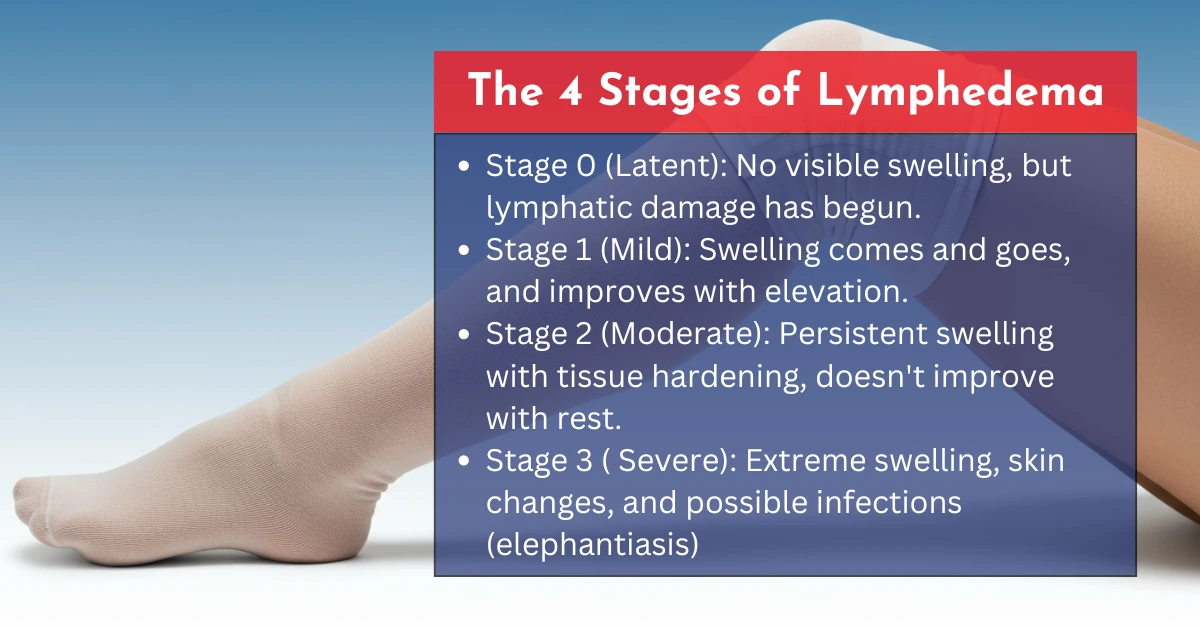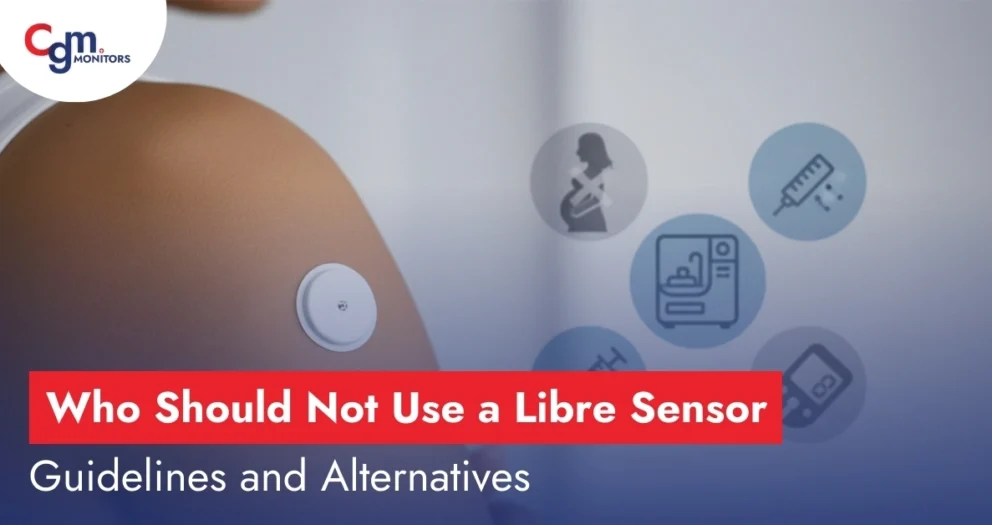Table of content
Lymphedema is a condition where lymph fluid builds up in tissues and causes swelling. It happens when your lymphatic system (which helps drain that fluid) doesn’t work properly—often due to surgery, cancer treatments, infections, or even genetics. Here we have discussed all 4 lymphedema stages, along with their symptoms and treatments.
Usually, it hits your arms or legs. But yes—it can also show up in the breast, abdomen, or even tummy area, especially if lymph nodes were removed or damaged.
Can Lymphedema Show Up in the Breast?
Absolutely. Breast lymphedema can happen—especially after surgery or radiation for breast cancer. What you might notice:
- One breast swelling or feeling heavy
- Skin tightness or thickening
- Tenderness or discomfort
- Sometimes, lumps or fluid build-up
The 4 Stages of Lymphedema
According to the International Society of Lymphology, there are four main stages (Stage 0 through Stage 3). Here’s how they break down—with symptoms, body parts involved, and what to do:
Stage 0 (Latent/Subclinical)
- What you feel: Nothing yet. Zero swelling.
- What’s happening: Lymph flow is impaired—even though you don’t see it.
- Where it affects: Could be the arm, leg, breast, or trunk.
- What to do: Prevention mode: wear compression if advised, move regularly, and watch for early symptoms.
Stage 1 (Early/Mild)
- Symptoms: Swelling is there, but it goes away if you elevate the limb. You might notice pitting (a dent that disappears).
- Body areas: Arms, legs, breasts, trunk.
- Treatments: Compression garments, gentle exercise, and manual lymph drainage (MLD). Often reversible in this stage.
Whether you are experiencing leg, breast, or abdominal lymphedema, lymphatic drainage machines like Bio Compression may help you manage it easily. These pneumatic compression pumps can be used with various types of compression garments, e.g., arms, arm and shoulder, bio vest, or leg sleeve. Moreover, these garments offer different chamber options, i.e., a 4-chamber option may be suitable for a person with moderate requirements, while an 8-chamber option may be required for an individual with a severe condition.\
Stage 2 (Moderate)
- Symptoms: Stage 2 lymphedema swelling no longer resolves with elevation. Skin starts hardening (fibrosis). Sometimes non-pitting.
- Areas involved: Most often arms and legs.
- Interventions: Compression bandaging, MLD, pumps, and more structured therapy—complete decongestive therapy (CDT) is often needed.
Stage 3 (Severe / Elephantiasis)
- Symptoms: Stage 3 lymphedema appears with major swelling, skin thickening, lumps, and risk of infection. The limb may be very large or rigid.
- Affected body parts: Arms, legs, abdomen, and genitals sometimes affected.
- Treatment: Surgical options (like vascularized lymph node transfer or liposuction), plus ongoing compression, MLD, physical therapy, and infection prevention. Wikipedia
Unsure of your eligibility?
Check your eligibility for a pneumatic compression pump now with CGM Monitors and receive your supplies at your door at no extra cost (within the USA).

Beyond Limbs: Other Risk Areas
Lymphedema can affect more than just arms and legs:
- Abdominal swelling if lymph nodes are impacted there
- Worsened by obesity (extra weight stresses lymph drainage)
- Areas like the groin or trunk can swell if lymph drainage is impaired
How It Progresses & How to Manage It
Early detection and consistent care are your best defenses. Here’s how you’d approach each stage:
Stages 0 & 1—Early Care
- Wear compression garments
- Move often and exercise gently
- Reduce sodium, stay hydrated, and manage weight
- Keep skin clean and moisturized to avoid infection
Stage 2—Moderate Management
- Use compression bandaging, along with compression garments
- Receive manual lymphatic drainage (MLD) sessions
- Lymphedema pumps may help reduce swelling
- Continue skin care, diet, and gentle movement regularly
Stage 3—Advanced Care
- Consider surgical treatments like VLNT or liposuction
- Continue compression therapy, MLD, pumps
- Engage in specialized physical therapy to maintain mobility
- Monitor for skin ulcers or infections closely
Good News
While there are different treatment options available for lymphedema. You can always make changes in your lifestyle and enjoy the benefits. Consuming lean protein, vegetables, and fruits, along with a light exercise, e.g., a 20 to 30-minute walk daily, may help you manage your conditions better.
Summary Table: Lymphedema Stages
| Stage | Symptoms | Severity | Suggested Treatment |
| 0 | No visible swelling | Latent/subclinical | Prevention: compression, exercise, monitoring |
| 1 | Reversible swelling | Mild & pitting | Compression, MLD, exercise |
| 2 | Irreversible swelling, fibrosis | Moderate | Bandaging, MLD, pump therapy, skin care |
| 3 | Severe swelling, skin changes | Elephantiasis | Surgery (VLNT/liposuction), therapy, strict skin care |
Final Notes
Lymphedema isn’t reversible—but it is manageable, especially when caught early. Whether you’re managing leg, arm, or breast lymphedema, Stage 1 or Stage 3, consistently using treatments like compression garments, MLD, and compression pumps can significantly improve quality of life.
If you have swelling you can’t explain, or swelling following cancer treatments or surgeries—don’t wait. Early action helps preserve function and mobility. Consider reading about lymphedema life expectancy.
Frequently Asked Questions
How many stages of lymphedema are there?
There are 4 stages of lymphedema:
Stage 0: no visible signs
Stage 1: swelling that goes away with elevation
Stage 2: persistent swelling with no positive elevation effects
Stage 3: major swelling, skin thickening, and risks of infection
Can lymphedema be treated with diet and exercise?
Better diet with lean proteins, fruits, and vegetables, combined with light exercise, can have positive effects; however, these changes can only help manage the condition.
Is lymphedema therapy possible at home?
Pneumatic compression devices like Bio compression are intended for use at a medical facility and at home. Check out your eligibility for a compression pump now.
Disclaimer: This blog is for informational purposes only and does not constitute medical, legal, or professional advice. While we strive for accuracy, errors or omissions may occur.







Write a comment
Your email address will not be published. All fields are required